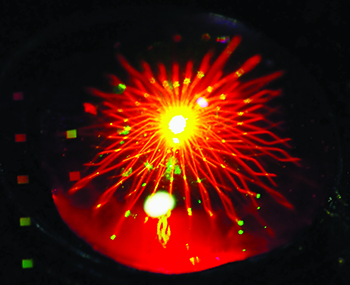
An excitation laser is diffracted by a nanoscale array, causing a bloom of internally reflected fluorescence within a droplet of fluorescent molecules. Credit: M.D. Lew, Washington University in St. Louis, USA
Researchers led by Nobel Laureate and OSA Fellow W.E. Moerner from Stanford University, USA, report improved accuracy of a single-optical-emitter imaging technique for 3-D tracking of individual molecules (Optica, doi: 10.1364/OPTICA.2.000985). Observing how molecules move and interact with their environment may lead to a better understanding of subcellular biological processes like cell signaling and division.
Moerner and his colleagues developed superresolution microscopy by using lasers to excite fluorescence from single molecules, thereby increasing imaging resolution beyond the diffraction limit—from 200 nm to 40 or 10 nm. This five-to-tenfold improvement in resolution, however, is still not powerful enough to accurately track single molecules in 3-D. To increase accuracy, the researchers incorporated a fluorescing nanohole array to correct for optical distortions across a 3-D localization microscope’s entire field of view.
Alex von Diezmann, Stanford doctoral candidate and the paper’s first author, says he created an array out of a thin aluminum film etched with 200-nm holes spaced 2.5 µm apart on a glass coverslip to calibrate the team’s 3-D microscope. When activated by a laser from below, a liquid fluorescent dye in the nanoholes emits a point of light, producing a grid-like pattern in the field of view that can correct field-dependent aberrations of 50 to 100 nm to less than 25 nm over an extended 3-D focal volume. Previous methods have used fluorescent nanobeads to correct optical errors, but the beads can only be used for a few select spots in the field of view. In an OSA press release, von Diezmann adds: “The fact that we demonstrated the presence of field-dependent aberrations, and showed that they could degrade images, is [also] an important part of this work.”
The researchers demonstrated their technique by tracking single protein molecule localization in bacteria. With the new nanohole array calibration technique, they were able to track in 3-D the proteins in 150-to-200-nm nanodomains.
